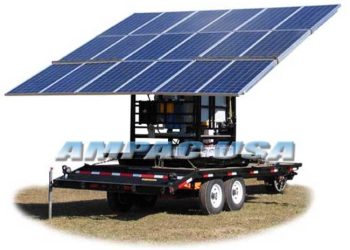In the heart of remote landscapes, where clean water can be a luxury, technology and nature have formed an unexpected alliance. Mobile solar systems purify water in remote areas, offering a beacon of hope to communities struggling with water scarcity. These innovative systems harness the sun’s energy, transforming it into a sustainable solution for one of humanity’s most pressing needs. But how exactly do they work, and what makes them so effective? Let’s dive into the world of mobile solar water purification and uncover the magic behind this life-saving technology.
There is an urgent need for clean water in remote areas.
Water, the essence of life, is something many of us take for granted. Yet, for millions of people living in isolated regions, access to clean water is a daily struggle. Traditional purification methods are often impractical due to the lack of infrastructure, unreliable electricity, and the high costs of transporting clean water.
- Health Impacts: Contaminated water is a breeding ground for diseases such as cholera, dysentery, and typhoid.
- Economic burden: The time and resources spent sourcing clean water can stifle economic growth.
- Environmental Stress: Over-reliance on unsustainable water sources can deplete local ecosystems.
The stakes are high, and innovative solutions are necessary. Install mobile solar systems.
Read: Water Recycling and Reuse: The Environmental Benefits
How mobile solar systems purify water
Mobile Solar water filtration Systems utilize solar panels to capture sunlight and convert it into electricity. This electricity powers water purification processes, making these systems both eco-friendly and cost-effective. Here’s a breakdown of the core components and how they work together:
Solar Panels
The heart of the system, solar panels, capture sunlight and convert it into direct current (DC) electricity. The system either uses this energy immediately or stores it in batteries for later use.
Water purification technology
You can utilize a variety of purification techniques, such as:
- Reverse Osmosis (RO): This process forces water through a semi-permeable membrane to eliminate contaminants and impurities.
- Ultraviolet (UV) Treatment: UV light kills bacteria, viruses, and other pathogens.
- Filtration Systems: Physical filters remove particulates and sediments from the water.
You can use these technologies separately or in combination to guarantee the purest water possible.
Mobility and portability
Mobile solar systems, designed for flexibility, mount on trailers or portable units for easy transportation to remote locations. Their compact and robust design makes them ideal for rough terrain and harsh environments.
Read: Global Water Crisis Fueling more conflicts, UN Report Warns
Benefits of Mobile Solar Systems
The advantages of using Mobile Solar water filtration Systems to purify water in remote areas are numerous and impactful.
Sustainable and Renewable
By harnessing the power of the sun, these systems provide a renewable energy source that reduces dependence on fossil fuels and minimizes carbon footprints. It’s a win-win for both communities and the environment.
Cost-Effective
While the initial investment may seem high, the long-term savings are significant. There are no ongoing fuel costs, and maintenance requirements are relatively low compared to traditional generators.
Accessibility
These systems bring clean water to places where traditional infrastructure cannot reach. For communities in deserts, mountains, or islands, mobile solar systems are often the only viable option.
Real-World Applications
Let’s explore some inspiring real-world applications of mobile solar systems for purifying water in remote areas.
Case Study 1: African villages
In several African villages, mobile solar systems have transformed lives. Prior to their introduction, women and children often walked miles to fetch water from unsafe sources. Now, with clean water readily available, these communities have seen improvements in health, education, and economic activities.
Case Study 2: Disaster Relief
In the aftermath of natural disasters, access to clean water is critical. Disaster-stricken areas have deployed mobile solar systems to provide immediate relief. For example, after the devastating earthquake in Nepal, these systems were instrumental in preventing waterborne diseases.
Read: Why Global Water Security Matters in 2024
Challenges and Solutions
Despite their benefits, mobile solar systems face several challenges. However, we can overcome these hurdles with innovation and dedication.
Initial Cost
The upfront cost of installing mobile solar systems can be a barrier. Solutions include:
- Grants and subsidies: Governments and NGOs can provide financial assistance.
- Community Funding: Local communities can pool resources to create a shared system.
Technical Expertise
Operating and maintaining these systems requires technical knowledge. Solutions include:
- Training Programs: Providing training for local technicians.
- Remote Monitoring: Utilizing IoT technology for remote diagnostics and maintenance.
Weather Dependency
Solar systems depend on sunlight, which can be unpredictable. Solutions include:
- Battery Storage: Storing excess energy during sunny days for use during cloudy periods.
- Hybrid Systems: Combining solar with other renewable energy sources like wind.
FAQs
What is a mobile solar system for water purification?
A mobile solar system for water purification is a portable unit that uses solar panels to generate electricity, which powers water purification processes like reverse osmosis, UV treatment, or filtration.
How effective are these systems at purifying water?
Mobile solar systems are highly effective and capable of removing a wide range of contaminants, including bacteria, viruses, and chemical impurities, ensuring safe drinking water.
Are mobile solar systems expensive?
While the initial cost can be high, they offer long-term savings through reduced operational costs and maintenance. Various financial aid options can help mitigate the initial investment.
Can these systems work in cloudy or rainy conditions?
Yes, by incorporating battery storage or hybrid systems, mobile solar systems can continue to operate even during less sunny periods.
Conclusion
Mobile solar systems purify water in remote areas, providing a lifeline to communities in need. They represent a perfect blend of technology and nature, harnessing the sun’s power to deliver clean, safe water. These systems not only address immediate health concerns but also foster long-term economic and environmental benefits. As we continue to innovate and overcome challenges, the potential of mobile solar systems will only grow, illuminating a brighter, cleaner future for all.










